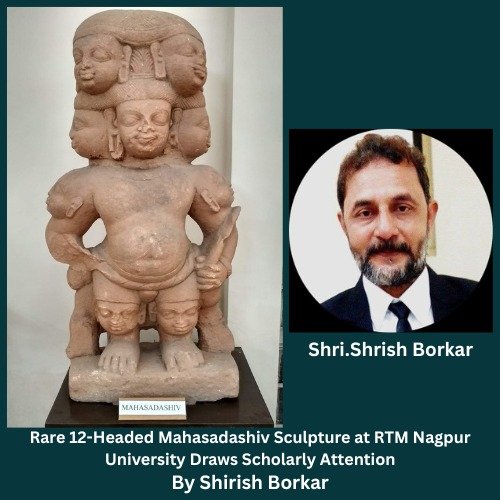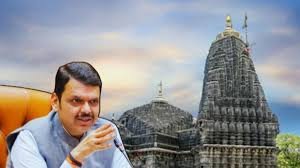
Rare 12-Headed Mahasadashiv Sculpture at RTM Nagpur University Draws Scholarly Attention By Shirish Borkar
Nagpur:-A rare and remarkable 12-headed sculpture of Mahasadashiv, dating from the 3rd to 7th century CE, has emerged as a significant focus of scholarly interest. Housed at the Rai Bahadur Dr. Hiralal Museum within the Post Graduate Department of Ancient Indian History, Culture & Archaeology at Rashtrasant Tukadoji Maharaj (RTM) Nagpur University, this unique artifact is believed to be one of the rarest known depictions of Siva in the world.
While academic studies on this particular iconographic form remain limited, its discovery has prompted growing enthusiasm among researchers seeking to decode its theological and artistic significance.
Siva’s Polycephalous Iconography: A Rare Form Emerges
Siva, a principal deity in Hinduism, is revered in both aniconic (formless, Ayakta-Nishkala) and iconic forms. His multi-headed representations are central to expressing his boundless divinity. While gods like Brahma and Vishnu are typically portrayed with up to four heads, Siva’s imagery often surpasses that—ranging from one to twelve or even twenty-five heads—highlighting his unique transcendental status.
Among these depictions, the polycephalous Vilaksana form has been of particular interest since the 2nd century BCE. Multi-headed Siva images such as the Caturmukha (four-headed) and Panchamukha (five-headed) lingas have been found across India. However, the 12-headed Mahasadashiv image, unearthed during the 1975–76 excavations at Mandhal near Nagpur, stands in a category of its own.
An Iconographic Enigma
The Mahasadashiv sculpture is a rare visual expression of Siva's theological concept of omnipresence. The deity is shown in a Sthanaka (standing) posture with two arms, holding a danda (staff) in his right hand and a tumbi (water pot) in his left. The heads are innovatively arranged—eight on two neck tiers, while the remaining four are positioned on the shoulders and thighs.
Each face is marked by serenity, with prominent eyes, broad noses, and distinct headdresses, giving the image a commanding and contemplative presence.
This configuration defies conventional classification, posing intriguing questions about its origin, symbolic meaning, and ritual function.
Scriptural Correlation: Theological Foundations
Scholars like N.P. Joshi, in his seminal article Early Forms of Siva, have linked this form to scriptural references from the Mahabharata and Rupamandana. In the Mahabharata, Siva is referred to as Dv?da?a Sarvapar?vamukha—the twelve-faced god who sees in all directions—aptly capturing the all-encompassing nature of Mahasadashiv as depicted in the sculpture.
This alignment between scripture and sculpture strengthens the argument that the artifact is not merely an artistic innovation but a profound theological symbol rooted in ancient textual traditions.
A Call for Deeper Inquiry
This 12-headed Mahasadashiv is more than an archaeological find—it is a gateway to understanding Siva's complex iconography, bridging art, theology, and historical context. As interest grows among historians, archaeologists, and Indologists, the sculpture stands to play a pivotal role in future academic discourse on Hindu iconography and religious symbolism.
Located at RTM Nagpur University, this extraordinary piece invites continued scholarly attention and offers immense potential to expand our understanding of early Indian religious art and the multifaceted persona of Lord Siva.
Nagpur:-A rare and remarkable 12-headed sculpture of Mahasadashiv, dating from the 3rd to 7th century CE, has emerged as a significant focus of scholarly interest. Housed at the Rai Bahadur Dr. Hiralal Museum within the Post Graduate Department of Ancient Indian History, Culture & Archaeology at Rashtrasant Tukadoji Maharaj (RTM) Nagpur University, this unique artifact is believed to be one of the rarest known depictions of Siva in the world.
While academic studies on this particular iconographic form remain limited, its discovery has prompted growing enthusiasm among researchers seeking to decode its theological and artistic significance.
Siva’s Polycephalous Iconography: A Rare Form Emerges
Siva, a principal deity in Hinduism, is revered in both aniconic (formless, Ayakta-Nishkala) and iconic forms. His multi-headed representations are central to expressing his boundless divinity. While gods like Brahma and Vishnu are typically portrayed with up to four heads, Siva’s imagery often surpasses that—ranging from one to twelve or even twenty-five heads—highlighting his unique transcendental status.
Among these depictions, the polycephalous Vilaksana form has been of particular interest since the 2nd century BCE. Multi-headed Siva images such as the Caturmukha (four-headed) and Panchamukha (five-headed) lingas have been found across India. However, the 12-headed Mahasadashiv image, unearthed during the 1975–76 excavations at Mandhal near Nagpur, stands in a category of its own.
An Iconographic Enigma
The Mahasadashiv sculpture is a rare visual expression of Siva's theological concept of omnipresence. The deity is shown in a Sthanaka (standing) posture with two arms, holding a danda (staff) in his right hand and a tumbi (water pot) in his left. The heads are innovatively arranged—eight on two neck tiers, while the remaining four are positioned on the shoulders and thighs.
Each face is marked by serenity, with prominent eyes, broad noses, and distinct headdresses, giving the image a commanding and contemplative presence.
This configuration defies conventional classification, posing intriguing questions about its origin, symbolic meaning, and ritual function.
Scriptural Correlation: Theological Foundations
Scholars like N.P. Joshi, in his seminal article Early Forms of Siva, have linked this form to scriptural references from the Mahabharata and Rupamandana. In the Mahabharata, Siva is referred to as Dv?da?a Sarvapar?vamukha—the twelve-faced god who sees in all directions—aptly capturing the all-encompassing nature of Mahasadashiv as depicted in the sculpture.
This alignment between scripture and sculpture strengthens the argument that the artifact is not merely an artistic innovation but a profound theological symbol rooted in ancient textual traditions.
A Call for Deeper Inquiry
This 12-headed Mahasadashiv is more than an archaeological find—it is a gateway to understanding Siva's complex iconography, bridging art, theology, and historical context. As interest grows among historians, archaeologists, and Indologists, the sculpture stands to play a pivotal role in future academic discourse on Hindu iconography and religious symbolism.
Located at RTM Nagpur University, this extraordinary piece invites continued scholarly attention and offers immense potential to expand our understanding of early Indian religious art and the multifaceted persona of Lord Siva.
While academic studies on this particular iconographic form remain limited, its discovery has prompted growing enthusiasm among researchers seeking to decode its theological and artistic significance.
Siva’s Polycephalous Iconography: A Rare Form Emerges
Siva, a principal deity in Hinduism, is revered in both aniconic (formless, Ayakta-Nishkala) and iconic forms. His multi-headed representations are central to expressing his boundless divinity. While gods like Brahma and Vishnu are typically portrayed with up to four heads, Siva’s imagery often surpasses that—ranging from one to twelve or even twenty-five heads—highlighting his unique transcendental status.
Among these depictions, the polycephalous Vilaksana form has been of particular interest since the 2nd century BCE. Multi-headed Siva images such as the Caturmukha (four-headed) and Panchamukha (five-headed) lingas have been found across India. However, the 12-headed Mahasadashiv image, unearthed during the 1975–76 excavations at Mandhal near Nagpur, stands in a category of its own.
An Iconographic Enigma
The Mahasadashiv sculpture is a rare visual expression of Siva's theological concept of omnipresence. The deity is shown in a Sthanaka (standing) posture with two arms, holding a danda (staff) in his right hand and a tumbi (water pot) in his left. The heads are innovatively arranged—eight on two neck tiers, while the remaining four are positioned on the shoulders and thighs.
Each face is marked by serenity, with prominent eyes, broad noses, and distinct headdresses, giving the image a commanding and contemplative presence.
This configuration defies conventional classification, posing intriguing questions about its origin, symbolic meaning, and ritual function.
Scriptural Correlation: Theological Foundations
Scholars like N.P. Joshi, in his seminal article Early Forms of Siva, have linked this form to scriptural references from the Mahabharata and Rupamandana. In the Mahabharata, Siva is referred to as Dv?da?a Sarvapar?vamukha—the twelve-faced god who sees in all directions—aptly capturing the all-encompassing nature of Mahasadashiv as depicted in the sculpture.
This alignment between scripture and sculpture strengthens the argument that the artifact is not merely an artistic innovation but a profound theological symbol rooted in ancient textual traditions.
A Call for Deeper Inquiry
This 12-headed Mahasadashiv is more than an archaeological find—it is a gateway to understanding Siva's complex iconography, bridging art, theology, and historical context. As interest grows among historians, archaeologists, and Indologists, the sculpture stands to play a pivotal role in future academic discourse on Hindu iconography and religious symbolism.
Located at RTM Nagpur University, this extraordinary piece invites continued scholarly attention and offers immense potential to expand our understanding of early Indian religious art and the multifaceted persona of Lord Siva.

.jpg)
















